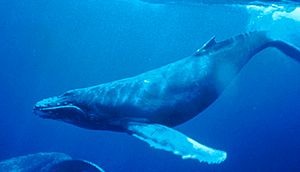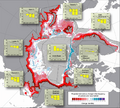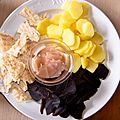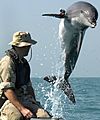Marine mammal facts for kids
Marine mammals are amazing animals that live in the ocean and other water environments. They are mammals, just like humans, but they have adapted to spend all or most of their lives in the water. This group includes well-known animals like whales, seals, manatees, sea otters, and even polar bears.
Some marine mammals, like whales and dolphins, live their entire lives in the water. They are called "fully aquatic." Others, like seals and sea lions, are "semiaquatic." This means they spend most of their time swimming, but they need to come back to land to have their babies, rest, and shed their fur.
Contents
Types of Marine Mammals
There are many different kinds of marine mammals, each with unique features. They are usually grouped into a few main categories:
Whales, Dolphins, and Porpoises
These animals are called cetaceans. They are fully aquatic, meaning they never leave the water. They have powerful tails to help them swim and a blowhole on top of their head to breathe.
- Toothed whales (like killer whales and dolphins) have teeth and hunt fish, squid, and even other marine mammals.
- Baleen whales (like humpback whales and blue whales) have baleen plates instead of teeth. They filter tiny organisms like plankton and small fish from the water.
Seals, Sea Lions, and Walruses
These are known as pinnipeds. They have flippers instead of legs, which are great for swimming. While they love the water, they still need to come ashore to rest, give birth, and molt (shed their old fur).
- Seals have short front flippers and move on land by wiggling their bodies.
- Sea lions have longer front flippers and can "walk" on land by rotating their back flippers forward.
- Walruses are famous for their long tusks and live in cold Arctic waters.
Manatees and Dugongs
These gentle giants are called sirenians. They are slow-moving herbivores, meaning they only eat plants, mostly seagrass and other water plants. They live in warm, shallow coastal waters.
Sea Otters
Sea otters are the smallest marine mammals. They are known for their thick fur, which keeps them warm in cold waters. They are very playful and often float on their backs, using rocks to crack open shellfish like sea urchins and clams. They live mostly in coastal areas of the Pacific Ocean.
Polar Bears
Polar bears are the largest land carnivores, but they are also considered marine mammals because they depend heavily on the ocean for survival. They live in the Arctic and hunt seals from sea ice. Their thick fur and blubber help them stay warm in freezing temperatures.
What Do Marine Mammals Eat?
Marine mammals have a wide range of diets, depending on their species and where they live.
- Some, like baleen whales, filter tiny zooplankton from the water.
- Many, like dolphins and seals, eat fish and squid.
- Sea otters enjoy shellfish like clams and sea urchins.
- Manatees and dugongs are vegetarians, feeding on sea grass and other aquatic plants.
- A few, like killer whales and leopard seals, are top predators and eat other mammals, including seals and penguins.
Where Do Marine Mammals Live?
Marine mammals can be found in all the world's oceans, from the icy poles to the warm tropics.
- Polar bears and some seals live in the Arctic and Antarctic.
- Manatees prefer warm, shallow coastal waters.
- Whales and dolphins travel across vast ocean expanses.
- Their habitats range from deep open ocean to shallow coastal areas, and even some freshwater rivers for certain dolphin species.
Images for kids
-
A leopard seal (Hydrurga leptonyx)
-
Marine mammal species richness: A) All species (n = 115), B) toothed whales (n = 69), C) baleen whales (n = 14), D) seals (n = 32), based on data from 1990 to 1999
-
Killer whale hunting a Weddel seal
-
Sea otters have dexterous hands which they use to smash sea urchins off rocks
-
A dugong feeding on the sea-floor
-
Map from the U.S. Geological Survey shows projected changes in polar bear habitat from 2005 to 2095. Red areas indicate loss of optimal polar bear habitat; blue areas indicate gain.
-
An adult and sub-adult Minke whale are dragged aboard the Nisshin Maru, a Japanese whaling vessel
-
Pilot whale meat (bottom), blubber (middle) and dried fish (left) with potatoes, Faroe Islands
-
Performing killer whale at SeaWorld San Diego, 2009
-
A dolphin wearing a locating pinger, performing mine clearance work in the Iraq War
See also
 In Spanish: Mamíferos marinos para niños
In Spanish: Mamíferos marinos para niños















